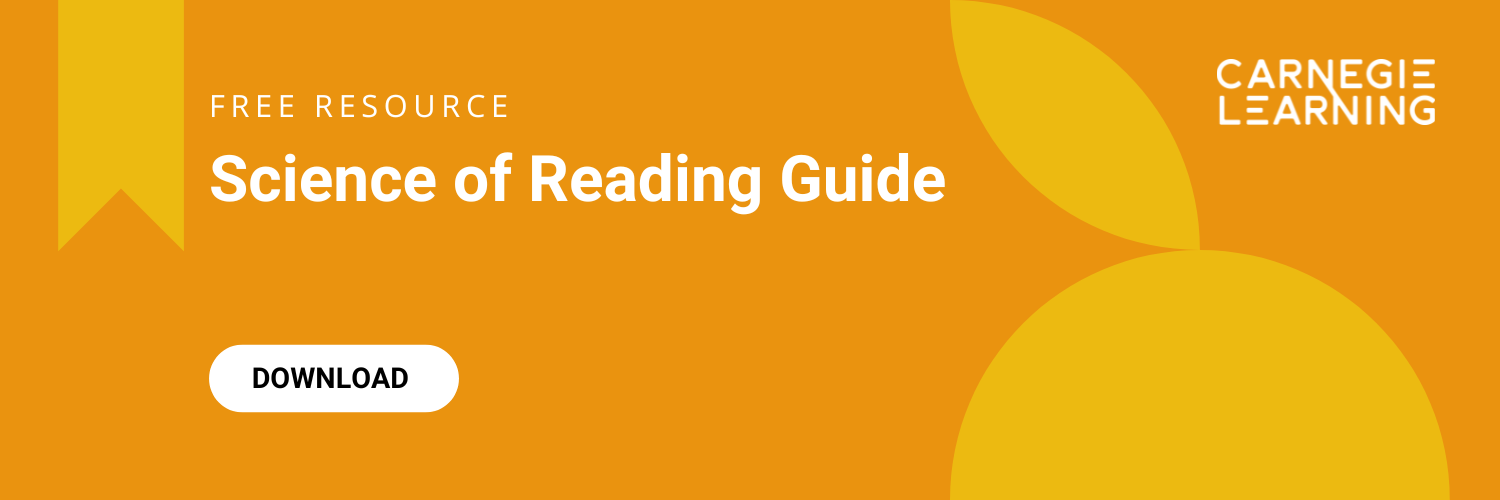How expression, rhythm, and tone transform reading comprehension
When I was preparing to work as a reading interventionist, I learned about the trifecta of intertwined elements that make up reading fluency: accuracy, rate, and prosody.
Accuracy and rate are straightforward to understand. Accuracy refers to how many words a person reads correctly, and rate refers to how quickly they read.
Prosody in reading is a bit more complex but equally important. It's what a reader does with their voice to convey meaning and emotion. For example:
- A reader might speed up their rhythm to show a character is scared or stressed
- They might slow down to indicate confusion or tiredness
- They can emphasize certain words to change meaning (compare "What would YOU do?" versus "WHAT would you do?")
- They can raise or lower their voice pitch, like when asking a question
Why is reading fluency important?
Before diving deeper into building better prosody in reading, let's understand why fluency matters.
When children read fluently, they can focus on understanding the text instead of struggling with individual words. Fluent reading includes accurate words, good pacing, and proper expression.
Fluency serves as the bridge between decoding and comprehension. The earlier students develop reading fluency, the better their chances for academic success across subjects, and the more likely they are to enjoy learning through reading.
How do students develop prosody in reading?
Many people assume that if students can decode words accurately, they'll naturally become fluent readers. However, research demonstrates that this isn't necessarily the case.
Many students—especially struggling readers—don't naturally develop reading fluency on their own. For these students, simply reading independently isn't enough to build the fluency needed for good comprehension.
Instead, these students need:
- specific practice through repeated oral reading
- regular exposure to fluent readers reading aloud to learn what accurate and properly paced reading sounds like
- opportunities to hear and practice good prosody in reading so they can experience the pleasure of expressive, meaningful stories
Why is prosody important for reading comprehension?
Non-fluent readers often read one word at a time. Even if they read the words correctly and quickly, their reading sounds choppy, with stilted expressions that don't connect ideas between sentences. This makes comprehension difficult.
When children use good pitch, emphasis, timing, and tone—in other words, good prosody in reading—they understand the text better. Research shows a reciprocal relationship between prosody and reading comprehension. Research shows that reading with good prosody helps students understand text better and improves their overall reading skills.
That's why focusing on prosody is essential when building fluency. However, many teachers wonder how to develop this skill since it goes beyond basic decoding and pacing. This is where assisted reading and repeated oral reading become valuable tools.

How to improve prosody in reading
Before asking students to improve fluency through repeated reading, we must expose them to models of fluent reading. Students need to hear text read aloud to understand how reading with accuracy, appropriate speed, and expression helps make sense of what they're reading.
Assisted reading can take several forms:
- teacher read-alouds where students follow along with the text
- peer volunteers reading from a shared text
- students listening to audiobooks while following along on the page
In each approach, students see the text as they hear it read aloud with proper prosody.
Once students have experienced these models of fluent reading, they can practice their own fluency through repeated oral reading. Research shows that reading texts multiple times effectively builds oral reading fluency, especially when each reading has a different focus (such as accuracy, pacing, or prosody).
Since rereading can become monotonous, though, here are strategies to make practice more engaging and help students monitor their own accuracy, rate, and prosody:
- Paired Reading: Match more fluent with less fluent readers and have them read short texts aloud to each other. For each rereading, shift the focus based on their fluency needs (accuracy, pacing, or prosody).
- Self-Recording and Analysis: Have students record themselves reading aloud, then listen together. Discuss strengths and challenges, talk about comprehension, and set a purpose for the next reading based on areas needing improvement. Have students record again, focusing on their new reading goal.
- Digital Reading Tools: Use tools like ClearFluency™, which allows students to record themselves and hear passages read aloud before they read. Such tools can listen to students read and provide real-time feedback when they struggle with words or phrases. Repeated readings with these tools can quickly build oral fluency since students receive immediate guidance for their rereading and can track progress toward accuracy, pacing, or prosody goals.
While some students might initially resist rereading passages, once they notice improvements in their fluency, they typically become more motivated. Research has found that rereading familiar passages not only improves how students read that specific text but also builds fluency skills they can use when reading new material.
Genre-specific prosody activities
Different types of text need different reading approaches. Here are some fun activities for each type:
Poetry
Poetry shows rhythm and rhyme patterns clearly:
- Have students mark beats in poems with dots and dashes
- Practice reading poems with big rhythm first, then natural reading
- Record students reading the same poem at the start and end of a unit
- Try "reading circles" where each student reads one line, keeping the same tone
Narrative Text
Stories give great chances for expressive reading:
- Give students character parts to read, with one as narrator
- Make "feeling cards" with words like happy, sad, or scared and have students read with that feeling
- Try reading the same story with different tones to see how it changes meaning
- Use picture books to practice matching voice to feelings
Informational Text
Even facts need good expression:
- Find words that need extra stress (like "most important" or "however")
- Practice reading headings with a stronger voice
- Highlight key facts that should be read with emphasis
- Compare a "flat" reading voice with an "excited" one when reading about discoveries
Students need to change how they read based on the type of text. This helps them become better readers.
Choosing the right texts for prosody practice
Not all texts work equally well for prosody practice. Here's how to pick good texts:
Good Text Features
The best texts for prosody practice have:
- Clear punctuation that shows where to change your voice
- Dialogue with different feelings
- Varied sentence types
- Content that brings out emotion
- Text that reads smoothly out loud
For new readers, use texts with repeated phrases and patterns. As students grow, give them texts with more varied sentences and feelings.
Reading Level Tips
For prosody practice, students should be able to read at least 95% of the words easily. This helps them focus on how they sound instead of figuring out words. Try these tips:
- For struggling readers: Use easier texts than they usually read
- For on-level readers: Use texts they can read on their own
- For advanced readers: Use texts with rich language and more feelings
Text Length Tips
Short passages work best for prosody practice:
- Grades K-2: 50-100 words
- Grades 3-5: 100-200 words
- Grades 6+: 200-300 word parts from longer texts
These shorter sections let students reread without getting tired. They can focus better on how their reading sounds.
Technology tools for teaching prosody
Today's classroom tech offers great ways to build better reading:
Recording Tools
Simple voice recording can really help:
- Let students record themselves reading, then listen and find ways to improve
- Make before-and-after recordings to see progress
- Let students practice with headphones before sharing with the class
- Most tablets and computers already have recording features
Visual Reading Tools
Some digital tools show pictures of how reading sounds:
- Sound wave displays show how loud or soft the reading is
- Pitch trackers show how the voice goes up and down
- These pictures help students see what they might not hear in their own reading
Web Resources
The internet has many useful resources:
- Clips from audiobooks show expert reading with good expression
- Videos of authors reading their books provide good models
- Free recording websites let students save and share their reading
While technology helps, remember that the teacher's own reading and feedback matter most. Tech works best when used along with your teaching.
Connecting prosody to other reading skills
Prosody links to many other reading skills:
Vocabulary Links
Prosody and vocabulary help each other:
- When students stress new words correctly, they remember them better
- Knowing what words mean helps students read with better expression
Try this: Have students read sentences with the same word used different ways, changing their voice to match each meaning.
Background Knowledge
Good prosody comes from understanding the topic:
- Students read with better expression when they know what they're reading about
- Teaching key ideas before reading helps with expression
- Knowing about a topic helps students stress the right words
Thinking Skills
Prosody works together with thinking while reading:
- Picturing: Students who "see" the story in their minds use more expressive voices
- Checking: Changes in voice can signal that meaning has changed
- Wondering: Asking questions while reading leads to more thoughtful expression
Better prosody means better reading overall. When we help students improve how they read aloud, we improve all their reading skills.
Best tools and activities for teaching prosody in reading
Teachers know that oral reading fluency is a crucial step toward reading comprehension. But teaching prosody effectively can be time-consuming, requiring you to listen to each student, analyze their reading, and provide targeted feedback.
This is where digital reading tools like ClearFluency™ can transform your fluency instruction. ClearFluency offers several advantages:
- It provides models of fluent reading so students hear proper expression
- It records students' reading to capture their progress over time
- It gives real-time feedback when students struggle with words or phrasing
- It saves teachers valuable instructional time by automating parts of the assessment process
- It makes prosody practice more engaging for students who like technology
By combining the research-based strategies we've discussed with tools like ClearFluency, you can help all students develop the prosody skills they need for better comprehension.
Ready to take your prosody instruction to the next level? Explore how ClearFluency can support your teaching while saving preparation, classroom, and assessment time. Visit our website to learn more about our latest resources for building reading fluency.
Remember, strong prosody isn't just about sounding good—it's about understanding deeply. Let's give our students every advantage in becoming truly fluent readers.
Fluency serves as the bridge between decoding and comprehension. When we strengthen prosody, we strengthen reading as a whole.
Megan Jensen, Director, Literacy Impact, Carnegie Learning

Tags:
ELA
May 2, 2023
Megan Jensen is a former reading specialist with experience developing K-12 writing instruction and blended professional development for adults across the United States, as well as literacy and library programming abroad. Her work continues to uphold her belief that every student can learn and that there is transformative power in supporting students in reading and writing about their worlds. She holds a B.A. in English from UCLA and an M.A. in International and Comparative Education from Teachers College, Columbia University.


